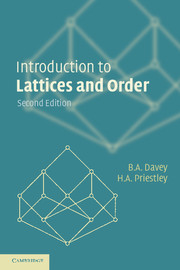Book contents
- Frontmatter
- Contents
- Preface to the second edition
- Preface to the first edition
- 1 Ordered sets
- 2 Lattices and complete lattices
- 3 Formal concept analysis
- 4 Modular, distributive and Boolean lattices
- 5 Representation: the finite case
- 6 Congruences
- 7 Complete lattices and Galois connections
- 8 CPOs and fixpoint theorems
- 9 Domains and information systems
- 10 Maximality principles
- 11 Representation: the general case
- Appendix A: a topological toolkit
- Appendix B: further reading
- Notation index
- Index
5 - Representation: the finite case
Published online by Cambridge University Press: 05 June 2012
- Frontmatter
- Contents
- Preface to the second edition
- Preface to the first edition
- 1 Ordered sets
- 2 Lattices and complete lattices
- 3 Formal concept analysis
- 4 Modular, distributive and Boolean lattices
- 5 Representation: the finite case
- 6 Congruences
- 7 Complete lattices and Galois connections
- 8 CPOs and fixpoint theorems
- 9 Domains and information systems
- 10 Maximality principles
- 11 Representation: the general case
- Appendix A: a topological toolkit
- Appendix B: further reading
- Notation index
- Index
Summary
In previous chapters we have introduced various classes of lattices. We have given examples of members of these classes, and described some of their general properties. We now turn our attention to structure theorems. Later (see Chapters 10 and 11) we give a concrete representation, as a lattice of sets, of any (bounded) distributive lattice. This chapter deals, less ambitiously, with the finite case, and reveals a very satisfactory correspondence between finite distributive lattices and finite ordered sets. We show that any finite distributive lattice L can be realized as a lattice O(P) of down-sets built from a suitable subset P of L. We begin by discussing in general terms the problem of finding a subset of a lattice L which, as an ordered set, uniquely determines L.
Building blocks for lattices
This chapter draws on the final section of Chapter 2, concerned with join-irreducible elements. In the remarks below we also make links with the material on concept lattices from Chapter 3, but familiarity with this is not essential for the representation theory that follows.
Remarks on lattice-building. In 2.42 we defined a non-zero element x of a lattice L to be join-irreducible if x = a ∨ b implies x = a or x = b for all a, b ∈ L. Proposition 2.45 showed that if L satisfies (DCC), and hence certainly if L is finite, the set J(L) of join-irreducible elements of L is join-dense; that is, that every element of L can be obtained as a (possibly empty) join of elements from J(L).
- Type
- Chapter
- Information
- Introduction to Lattices and Order , pp. 112 - 129Publisher: Cambridge University PressPrint publication year: 2002



